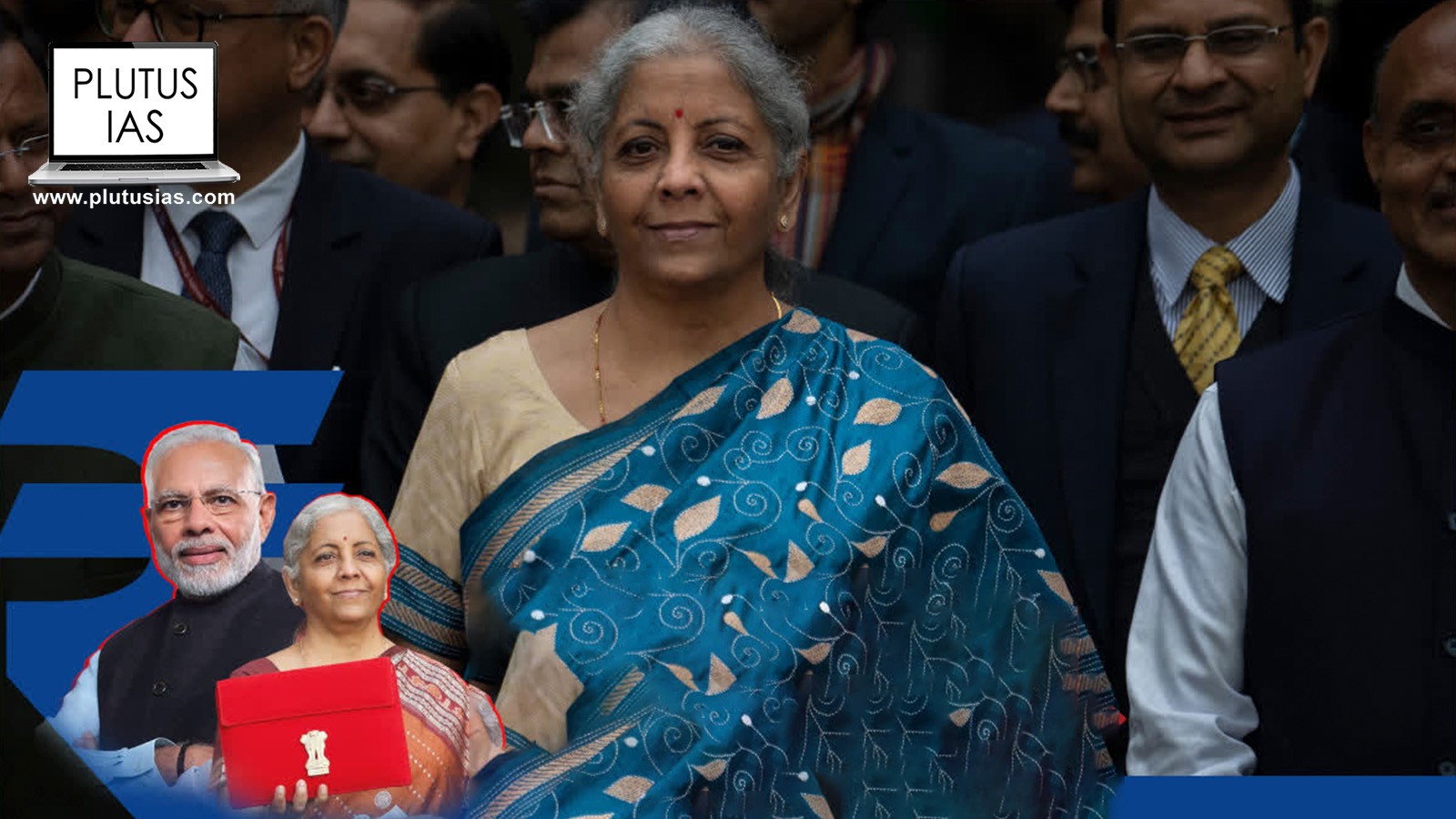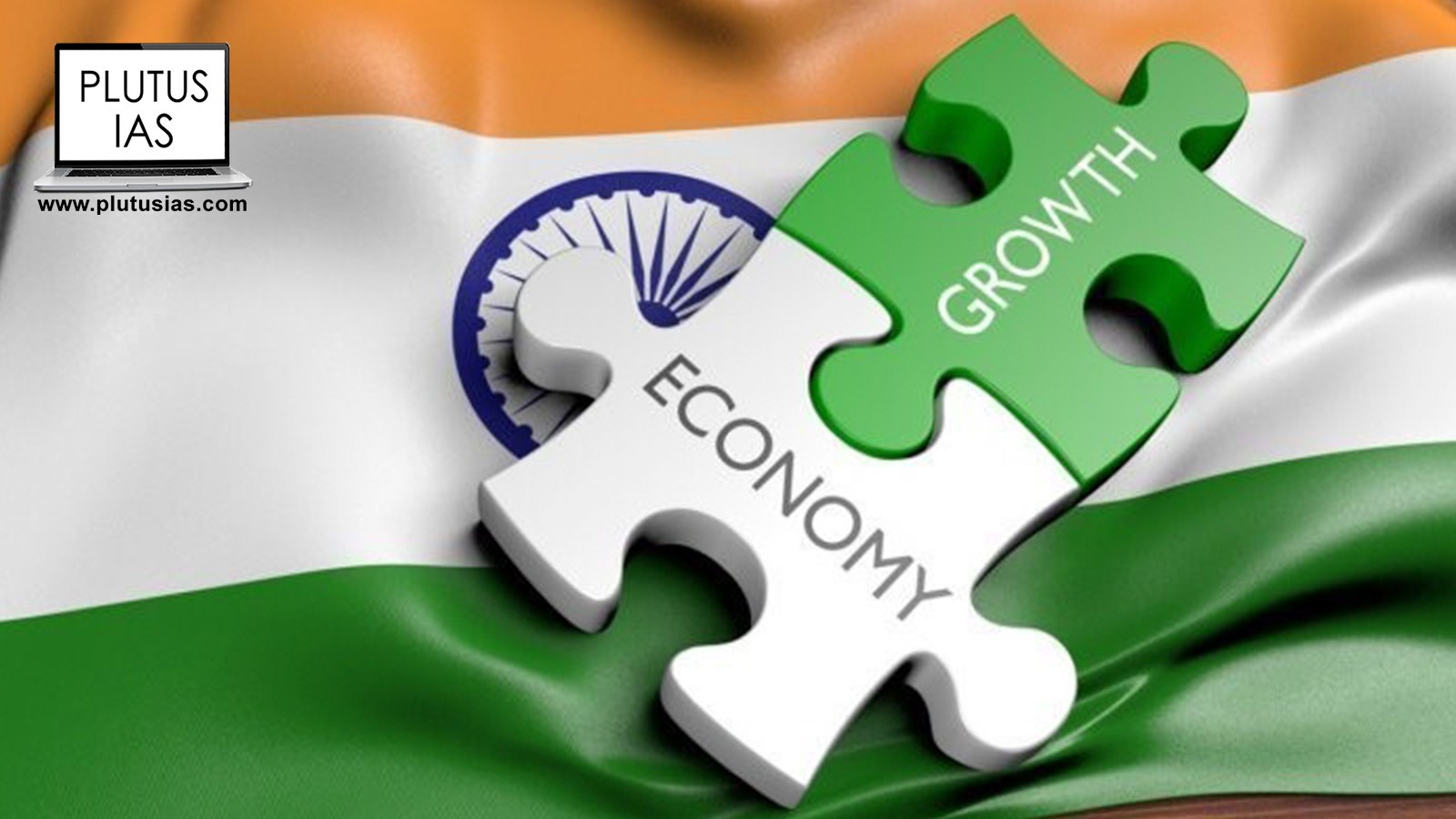09 Feb fiscal consolidation
Source – The Hindu and PIB.
General Studies – Growth of Indian Economy, Fiscal Consolidation, Fiscal Deficit, Gross Domestic Product, Direct Taxes, Indirect Taxes.
Why in the News ?

- In February 2024, India’s Finance Minister Nirmala Sitharaman, while presenting her interim budget in the Parliament, had said that a target has been set to limit India’s fiscal deficit in this financial year.
- It is worth noting that India is facing fiscal challenges in dealing with its national debts, hence in its interim Budget 2024-25, the Finance Ministry has reduced India’s fiscal deficit to 100 per cent of the Gross Domestic Product (GDP) in the financial year 2024-25. It has been decided to reduce the GDP growth to 5.1%.
- In her budget speech, the Finance Minister spoke about the government’s aim to reduce the fiscal deficit to 5.1% of GDP in 2024-25 and to 4.5% by 2025-26, which surprised many economic analysts, who expected little. Had expected a higher deficit target.
- The government aims to limit the fiscal deficit to 5.8 per cent of gross domestic product (GDP), as against 5.9 per cent estimated in the first budget for the fiscal year, and aims to reduce the fiscal deficit by 2025-26 on the back of a strong surge in tax revenues. Emphasis has been laid on keeping the target below 4.5 percent.
- Direct tax revenues have seen a sharp increase, with income tax 13.5 per cent higher than the budget estimate and securities transaction tax (STT) revenue 15.8 percent higher than the budget estimate for this financial year.
- For the next financial year, direct tax collections, which include income tax and corporate tax, are estimated to grow by 13.1 per cent to Rs 21.99 lakh crore. In the current financial year 2023-24, direct tax revenue is estimated to increase by 17.2 percent on an annual basis to Rs 19.45 lakh crore.
- Income tax collections have seen a sharp growth in 2023-24 and are expected to be Rs 1.2 lakh crore higher than the Budget Estimate, while corporate tax collections have been maintained at the Budget Estimate level of Rs 9.23 lakh crore. With this, income tax revenues are seen exceeding corporate tax collections, even though they were kept at a lower level than corporate tax revenues in the Budget Estimates for 2023-24.
- Securities transaction tax, which is levied on securities traded on stock exchanges, is estimated to rise to Rs 32,000 crore in the revised estimates for 2023-24, an increase of 27.6 per cent over the actual revenue in 2022-23. STT revenue is estimated to increase to Rs 36,000 crore for 2024-25.
- The government’s gross tax revenue is expected to increase by 11.5 percent to Rs 38.31 lakh crore in the next financial year.
- The Centre’s net tax revenue is estimated to grow by about 12 per cent to Rs 26.02 lakh crore in 2024-25. This compares with a 10.8 per cent increase over actual revenues in 2022-23 in the revised estimate for the current financial year 2023-24. The growth rate of around 12 percent of tax revenues projected for 2024-25 is much higher than the 10.5 percent nominal GDP growth projected for the budget arithmetic of 2024-25.
- The strong growth in tax revenue reflects higher tax buoyancy, which stands at 1.2 in the revised estimate for FY 2023-24, compared to 1.0 in FY23. For 2024-25, the tax jump is seen at 1.1.
- Indirect tax collections, which include customs duty, excise duty and GST (including compensation cess), are expected to fetch the government Rs 16.22 lakh crore in 2024-25.
- In the current financial year, the revised estimates of customs duty and excise duty collections have been revised to Rs 2.19 lakh crore and Rs 3.08 lakh crore, respectively, while GST collections (including compensation cess) are estimated at the budgeted level of Rs 9.57 lakh crore. ,
- Finance Minister Nirmala Sitharaman said in the Parliament of India that – “The government is not only keeping pace with fiscal consolidation but also improving it. Not only aligning with the fiscal consolidation roadmap that we gave earlier, but also improving it is a priority for the government.”
Fiscal deficit :

- Definition: The difference between the total revenue of any government and its total expenditure is called fiscal deficit. Whenever the government’s expenditure exceeds the revenue it receives, the government has to either borrow money or sell its government assets to meet the deficit.
- Primary source of revenue: The primary source of revenue for any government is tax. Tax receipts in 2024-25 are expected to be ₹26.02 lakh crore, while total revenue is estimated at ₹30.8 lakh crore. Total government expenditure for the same period is estimated at ₹47.66 lakh crore.
National debt :
- The national debt of any country is the total amount that the government of a country has to pay to its creditors at a given time.
- Government debt includes various liabilities including domestic and external debt along with obligations of schemes such as small savings, provident funds and special securities.
- These liabilities include both interest payments and repayment of the principal amount, placing a considerable financial burden on the government’s finances.
- This is usually the amount of debt that the government has accumulated over several years by borrowing to finance fiscal deficits and deficits.
- The higher the government’s fiscal deficit as a share of GDP, the less likely it is to make payments to its creditors without any hassle.
Financing of fiscal deficit by the government :

- Borrowing from the market: The government borrows money from the market through its bonds to meet its fiscal deficit, the lender from the market buys the bonds issued by the government. From which the government receives income. In 2024-25, the Center aims to borrow ₹14.13 lakh crore from the market, lower than the target for 2023-24.
- Indirectly providing funds to the government by the Reserve Bank of India: Central banks like the Reserve Bank of India (RBI) play an important role in the credit market by indirectly providing funds to the government, by purchasing government bonds in the secondary market.
- Monetary Policy of the Government: Monetary policies of the government also play an important role in reducing the cost of borrowing money from the market for the governments.
- Central Bank Lending Rates: Central Bank lending rates for the government also affect the fiscal deficit of the government. For example – Central bank lending rates in many countries were close to zero before the Covid pandemic, but they have increased rapidly after the pandemic. This makes it more expensive for governments to borrow money. It is because of the lending rates of the Central Bank that the Central Government is determined to reduce its fiscal deficit.
Role of fiscal deficit :

Inflation : High fiscal deficit can lead to inflation, as the government may resort to printing money to meet the deficit. Fiscal deficit reached a high of 9.17% of GDP in 2020 during the pandemic. It has declined significantly since then and is expected to reach 5.8% in the year 2023-24.
Building confidence among creditors : Any fiscal discipline, reflected in a lower deficit, can enhance confidence in the government among market creditors. This could potentially improve the rating of the bond and also reduce the cost of borrowing. Lower fiscal deficit indicates better government fiscal discipline. This may lead to higher ratings of Government of India bonds. When the government relies more on tax revenues and borrows less, it increases lender confidence and reduces the cost of borrowing.
Public debt management : A high fiscal deficit under any circumstances can put pressure on the government’s ability to manage public debt. Due to this, India’s public debt can increase at a rapid pace, which also affects the financial management of the country.
Getting cheap loans from the international market : It makes the process extremely simple for any government to issue its bonds in foreign markets and get cheap loans to compensate for the low fiscal deficit. Through this process also the fiscal deficit is reimbursed by the government.
Main methods of measuring fiscal deficit :
Fiscal deficit = Total expenditure – Total receipts (except borrowing).
Revenue Deficit : Revenue deficit in any business or for any government is determined by subtracting the total revenue expenditure from the total revenue receipts. Therefore
Revenue deficit = Total revenue receipts – Total revenue expenditure.
Negative GDP ratio: Negative GDP ratio is a method of measuring how much a country owes on its GDP. Therefore
Debt to GDP = Total debt of the country / Total GDP of the country.
Laws related to fiscal management :
Fiscal Responsibility and Budget Management (FRBM) Framework :
- The FRBM Act, enacted in 2003, set ambitious targets for debt reduction, aiming to limit general government debt to 60% of GDP by 2024-25. The Fiscal Responsibility and Budget Management (FRBM) framework failed to achieve its stated goals. As a result, the outstanding debt of the Central Government of India exceeded the prescribed limit.
- The FRBM Review Committee report has recommended a debt-to-GDP ratio of 60% for the general (combined) government by 2023, which includes 40% for the central government and 20% for the state governments.
Measures to manage national debt and fiscal deficit in India :

To increase revenue collection :
- There is an urgent need to strengthen tax administration and its strict compliance to improve revenue collection and widen the tax base by the government.
- There is also a need to impose environmental taxes or taxes on luxury goods, new taxes or duties on property to diversify revenue sources.
Fiscal discipline and consolidation :
- Compliance with the FRBM Act is of utmost importance to comply with the fiscal consolidation targets. The government should aim to gradually reduce the fiscal deficit and GDP ratio to ensure sustainable public finances.
- The government’s implementation of prudent fiscal policies along with rationalization of its expenditure, revenue enhancing measures and reforms in subsidies can reduce its dependence on borrowing and help manage fiscal imbalances.
Creating Debt Management Strategies :
- The government needs to develop a prudent debt management strategy to optimize the cost of borrowing and minimize refinancing risks.
- There is a need to diversify the investor base and sources of financing in domestic and international markets to reduce the risk of market volatility.
Reforms at structural level :
- There is a need to undertake structural reforms aimed at improving the efficiency and competitiveness of the economy, including labor market reforms, ease of doing business initiatives and improving governance.
- To enhance growth potential and maintain fiscal stability, it is necessary to address structural constraints and challenges in sectors such as agriculture, manufacturing and services.
To conduct a comprehensive review of government expenditure :
- The government should conduct a comprehensive review of government expenditure to prioritize spending on key sectors such as public health care, education and infrastructure.
- Policies should be made to reduce existing non-essential provisions and subsidies to ensure targeted support to the country’s deprived communities and vulnerable populations living below the poverty line.
Conclusion/ Solution :
- By implementing a combination of fiscal consolidation measures, India can effectively manage its national debt and fiscal deficit while ensuring fiscal stability, economic growth and long-term prosperity.
- Achieving fiscal sustainability requires a balance between short-term stabilization efforts and long-term structural reforms.
- Fiscal deficit, the difference between government revenue and expenditure, has a significant impact on inflation, market confidence, debt management and international borrowing.
- The government’s plan to reduce the fiscal deficit in the coming years involves a delicate balance of revenue generation and expenditure control.
- Announcing consolidation plans and measures is a prerequisite for restoring public finances in India and maintaining market confidence. In India its objective is to reduce government deficit and debt accumulation.
Practice Questions for Preliminary Exam :
Q,1. Consider the following statements regarding fiscal consolidation.
- The government borrows money from the market through its bonds to meet its fiscal deficit.
- High fiscal deficit can lead to inflation.
- The difference between the total revenue of the government and its total expenditure is called fiscal deficit.
- Government debt includes various liabilities including domestic and external debt along with obligations of schemes such as small savings, provident funds and special securities.
Which of the above statement /statements is/ are correct ?
(A). Only 1, 2 and 3
(B). Only 2, 3 and 4
(C) None of these.
(D). All of these.
Answer – (D)
Practice Questions for Main Exam :
Q.1. Define fiscal deficit and national debt and discuss how fiscal consolidation is necessary to strengthen India’s GDP and Indian economy. Present a logical explanation.
Qualified Preliminary and Main Examination ( Written ) and Shortlisted for Personality Test (INTERVIEW) three times Of UPSC CIVIL SERVICES EXAMINATION in the year of 2017, 2018 and 2020. Shortlisted for Personality Test (INTERVIEW) of 64th and 67th BPSC CIVIL SERVICES.
M. A M. Phil and Ph. D From (SLL & CS) JAWAHARLAL NEHRU UNIVERSITY, NEW DELHI.



No Comments